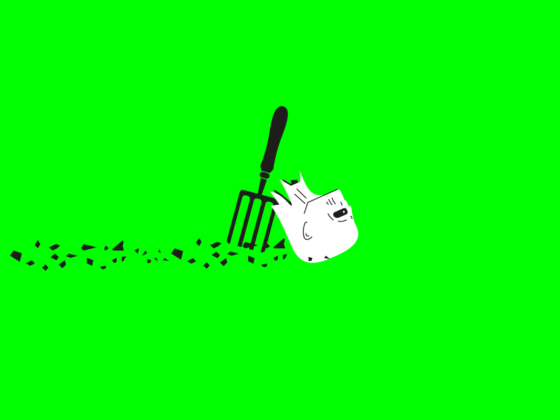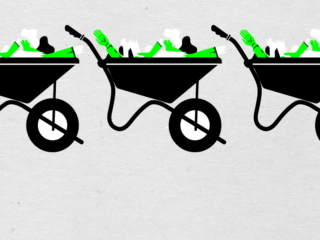So you’ve had a bumper crop of, well, something. Here’s How to store it safely – and edibly – through winter

Gluts are a fact of gardening life. One week, you have 20 courgettes, an amount scientifically proven to be more than any human can reasonably eat. The next week, nil, nada, none courgettes. (Nourgettes?) This, if you’re happy to give away or compost your excess harvests, is of course fine. But if you’d like to actually eat all the food you’ve grown – which is sort of the point of zombie gardening – that means getting clever with storage.
Storage is something we’ve struggled with over the years. We now have two big chest freezers, and fill them to the max with vegetables and fruit as the summer progresses. But not all the things we produce freeze well. So we’ve had to develop a few other techniques for keeping the food we grow in good condition, and away from interested parties such as mice and rats.
We should point out that our book devotes a whole chapter to how, in a full-blown, no-electricity apocalypse, you can preserve the food you’ve grown. (Hint: you need a lot of sugar. And vinegar.) But as the end of the world hasn’t quite started – yet – you have a few other methods to choose from. Here are a few of the ones we’ve found the easiest and most reliable. Give them a try, and gluts should become less of a problem, and more of a gardening bonus.
Potatoes
The problem Potatoes need to be kept cool and in the dark to stop them going green (read: poisonous) and beginning to sprout. They also need a reasonable air-flow to prevent moisture build-up and fungal attack, can’t be allowed to freeze, and need to be checked regularly to remove any that are rotting. In the house is likely to be too warm, so traditionally you’d keep them in sacks in an outhouse or shed. But if you leave sacks on the floor, or even on a shelf, mice and rats get to them.
To avoid this, one year we tried hanging sacks up from the rafters of a barn – but the sacks were so heavy and difficult to lift that collecting a few spuds for dinner became a bit of a chore. And anyway, judging from by the holes, rats are gymnastic enough to reach the bottom of hanging-up stuff. Presumably by standing in little rat-pyramids, like American cheerleaders. But with bigger teeth.
The answer Galvanized feed bins keep rodents out, but they’re not ventilated enough to maintain spuds in good condition. So instead we reuse old plastic dustbins, the kinds with clip-on, light-excluding lids, and drill them with plenty of ventilation holes.
To stop mice and rats gnawing on the holes and then squeezing through, we use a DIY version of granary stones: those big lumps of granite, shaped a bit like mushrooms but with a wider base, that you sometimes see used as ornaments in country gardens. Once upon a day, farmers would sit the corners of raised wooden grain sheds on these stones, and the horizontal bases of the mushroom-tops stopped rodents from climbing up and getting to the grain. Balancing a dustbin on a central pedestal of four house bricks may not be as pretty, but it has much the same effect. Without you having to pay a small fortune at an architectural salvage yard.
We have four bins-on-bricks sitting in a frost-free garage: three are filled up as we harvest potatoes through the summer, the fourth is empty. Every few weeks in winter we move the potatoes from a full bin into an empty one, chucking out any rotters as we go. Using this system, potatoes we harvested in August will stay useable until the following spring. And the rats stay hungry.
Apples
The problem Apples tend to ripen on a tree pretty much all at once, and need picking fast before wasps, wind, birds and other problem-makers spoil them. Once picked, they need to be stored in cool, airy but frost-free conditions, ideally without touching each other. So traditionally they’d be wrapped individually in paper and laid out on wooden racks, either attached to a wall or stacked inside a rodent-proof wire-mesh box. As with spuds, you’re meant to check them regularly to remove any that are rotting, otherwise the bad ’uns infect all the others (hence the phrase “one bad apple spoils the barrel”). This is all great, but in a good year a mature standard apple tree might give you 100-plus apples – that’s a lot of wrapping, unwrapping and checking, particularly when you realise that the fruit won’t last more than a few months without going soft, wrinkly, and unappealing to all but the most ardent apple-lover.
The answer Dry ’em. Slow, low-temperature drying drives out nearly all of the water from apples’ flesh, leaving them super-sweet, super-thin and super-storable. You can do this an oven with the door open, but an electric dehydrator is more effective and energy-efficient – we have an Excalibur and wouldn’t be without it, not least because it will dry and store much other garden produce, including garlic, nuts, fruit, berries, and every kind of herb.
To prepare apples for drying, slice them into thin, even slices using a sharp knife or mandolin (easiest, as it cores them at the same time). If you prefer your slices not to brown, soak them for a minute or two in a solution of 5ml citric acid to 500ml water, then dry them overnight, either on baking paper in a low oven or laid out on the trays of a dehydrator. Ten dried apples will pack into a 0.35 litre Kilner clip-top jar and keep in the cupboard for up to a year; which means just a metre of shelf space is enough to store a whole tree’s worth of fruit. Though they’re so delicious they’ve usually all gone by Christmas.
Pears
The problem Pears need picking just before they ripen, or their texture once ripe will be grainy and unpleasant. Once picked, summer/early-ripening varieties of pears such as Williams or Conference should ripen after a week or so kept somewhere warm. But winter/late-ripening varieties such as Nelis or Beurre d’Anjou need an extended cold snap first. Either way, this usually means picking a tree’s worth of small, unripe fruit at some point between August and November, and then wondering what to do with them.
The answer In an apocalypse, we would use a glut of pears to make perry, which a) is basically cider but nicer and b) lasts forever. But for now we pick all our pears when their skins first start to change colour; then we put them in large paper bags and store them in the fridge. Summer varieties come out first, a few at a time, and get left in a bowl on the kitchen counter until the necks give slightly when they’re prodded. Winter varieties will stay in the fridge for a couple of months, then get the same treatment. And yes, we still might make some perry.
Tomatoes
The problem Tomatoes are the classic glut harvest. From July to mid-September you have billions of the things, but then summer is over, the greenhouse is empty, and you still want bolognese. Making tomato sauce to freeze or (if you have the kit) pressure-can is one way round this, but because of the sheer amount of tomatoes your vines will be producing, it eats up a lot of time and energy. In summer, we have other things to do than stand at a cooker stirring sauce every day for hours at a go.
The answer Many chefs will tell you you should never keep tomatoes in the fridge, as cold ruins their tomatoey taste. But here’s the thing: ripe plum tomatoes (eg varieties such as San Marzano) laid out on a piece of carboard in the freezer for 24 hours, then vacuum packed in batches of six or seven, keep well for at least a year. They tend to burst their skins as you defrost them, but when you’re making sauce that actually saves time – and as long as they’re fully ripe before you start, so that their natural enzyme processes have had time to do their job, we’ve never detected any loss of flavour. And oh it is so much nicer to be able to make a bit of sauce as you need it, rather than trying to prepare nine months’ supply all at once.
As for salad varieties – the round, juicier kinds like Shirley or Gardeners’ Delight – cut them in half and put them in a low oven or dehydrator; dried until they’re somewhere between chewy and brittle, they’ll keep in an airtight container in the fridge for at least six months.
Garlic and onions
The problem Garlic and onions don’t need to be kept in the dark, but they do last longer in cool, dry conditions, so cupboards in hot, steamy kitchens aren’t ideal. A fridge tends to be too cold, though – it makes them think winter has come, so when you take them out they think, “Yippee, spring!” and quickly start to sprout. They also need a good airflow around them, which ideally means hanging them up in a shed or garage. But hang them how? Plastic bags are too damp and well, plastic.
The answer Braiding alliums is an old technique, where you weave the long, dried leaves of 10-12 garlic or onion bulbs into a plait, tied off with string, that you can hang from a nail somewhere. It’s easy to do – YouTube will be happy to show you how – and for some reason bulbs that haven’t been cut off from their necks seem to last longer than ones that have been de-stemmed. Garlic braids look kind of cool, too.
Carrots
The problem Carrots tend to dry out, go limp and lose their flavour if you keep them long-term in the fridge. But they’re also not entirely frost-hardy, so leaving them in the ground all winter can be a bit risky.
The answer Traditionally you’re meant to keep root veg like carrots, celeriac and beetroots in cellars, packed in boxes of ever-so-slightly slightly damp sand. So one particularly bitter winter we spent a day lifting and trimming a whole bed of carrots, before packing them in sand in old wooden crates. But rummaging around in a box of damp sand whenever we felt like a crudité was pretty depressing: like looking for something to eat in a tray of cat litter. So now we leave them in the ground; if a hard freeze is forecast we cover the soil with some kind of insulation: horticultural fleece, a layer of straw or leaf mould, or flattened cardboard boxes weighted down with stones. We whip this off as soon as the weather is kinder, so that slugs and mice won’t take advantage of the cover and eat the crop beneath. And, hooray, we can leave the sandbox for the cat.
Courgettes
The problem A healthy courgette plant will crop very heavily for a few weeks in August and September, which means you have loads of fruit (and they are a fruit) arriving in the kitchen all at once. But because of their high water content, courgettes don’t freeze or dehydrate well. And they also don’t store in or out of a fridge for more than a few weeks.
The answer Luckily, courgette glut-season pretty much coincides with apple and tomato glut-season. So we’re ending on this extremely tasty note: our favourite spiced chutney recipe, invented by the good folk at FarmersGirlKitchen, and made with bags of apples and courgettes – to which we like to add a few toms for good luck. May we recommend you pick over the last of your veg garden and go make a few jars right now? Your taste buds will thank you. And so will your store cupboard.

ALLIUMS Say “alliums” to a florist and they’ll reply, “Large round purple flower; that’ll be three quid thank you.” Say it to a garden designer and they’ll say, “Plant behind low box hedges for a structural impact”. Say it to a zombie gardener and they’ll reply “Veg family that includes onions, leeks, garlic and shallots.” Followed by “Good source of vitamins C and B6” and “Yum”.











